Human Resource Management: A Review
VerifiedAdded on 2020/02/12
|15
|4966
|453
AI Summary
This assignment delves into the multifaceted world of human resource management (HRM). It examines HRM's contributions to sustainable development and entrepreneurial endeavors. The review analyzes various aspects of HRM, including workforce differentiation, strategic human resource management, talent management, and the influence of technological advancements. It also highlights the importance of human capital in driving organizational performance and achieving long-term success.
Contribute Materials
Your contribution can guide someone’s learning journey. Share your
documents today.
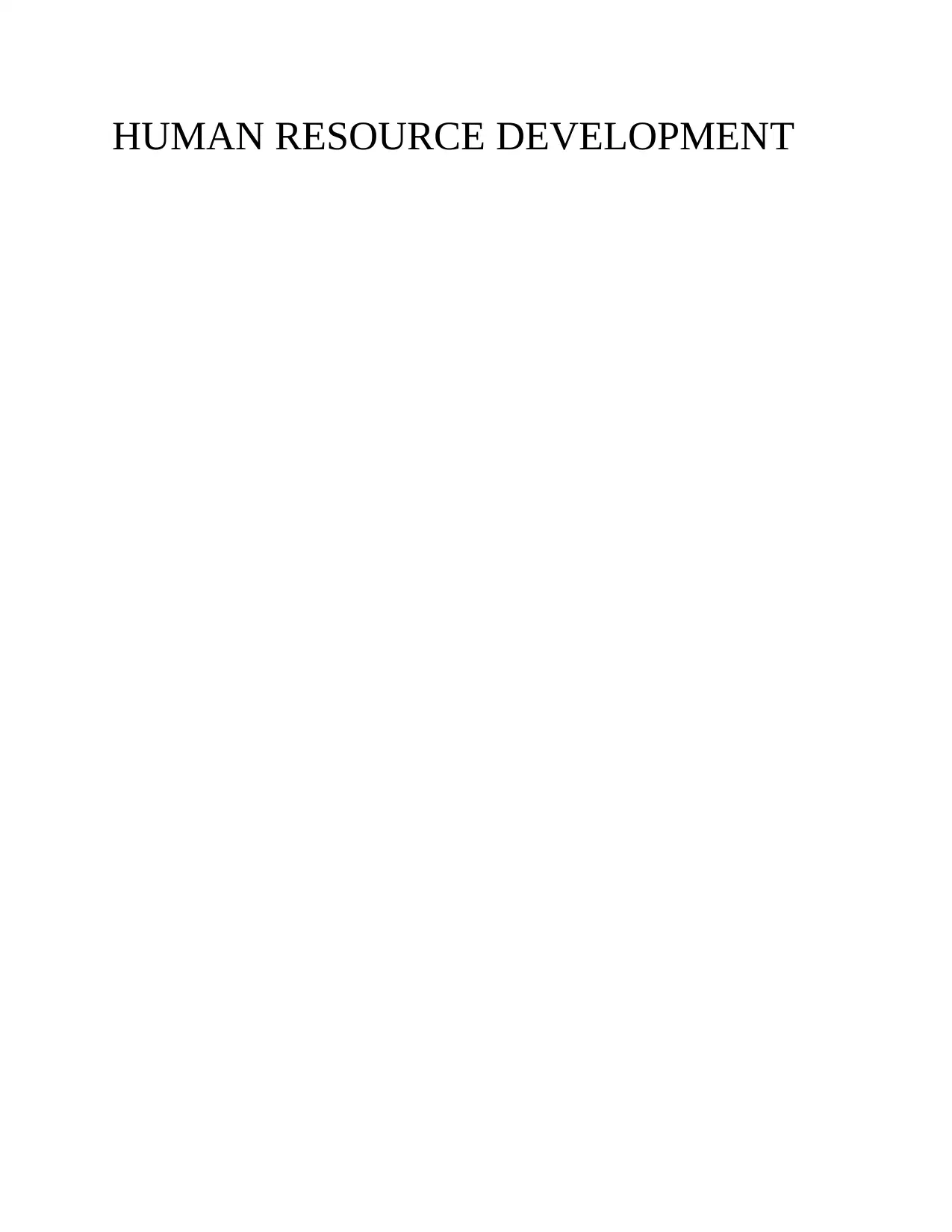
HUMAN RESOURCE DEVELOPMENT
Secure Best Marks with AI Grader
Need help grading? Try our AI Grader for instant feedback on your assignments.
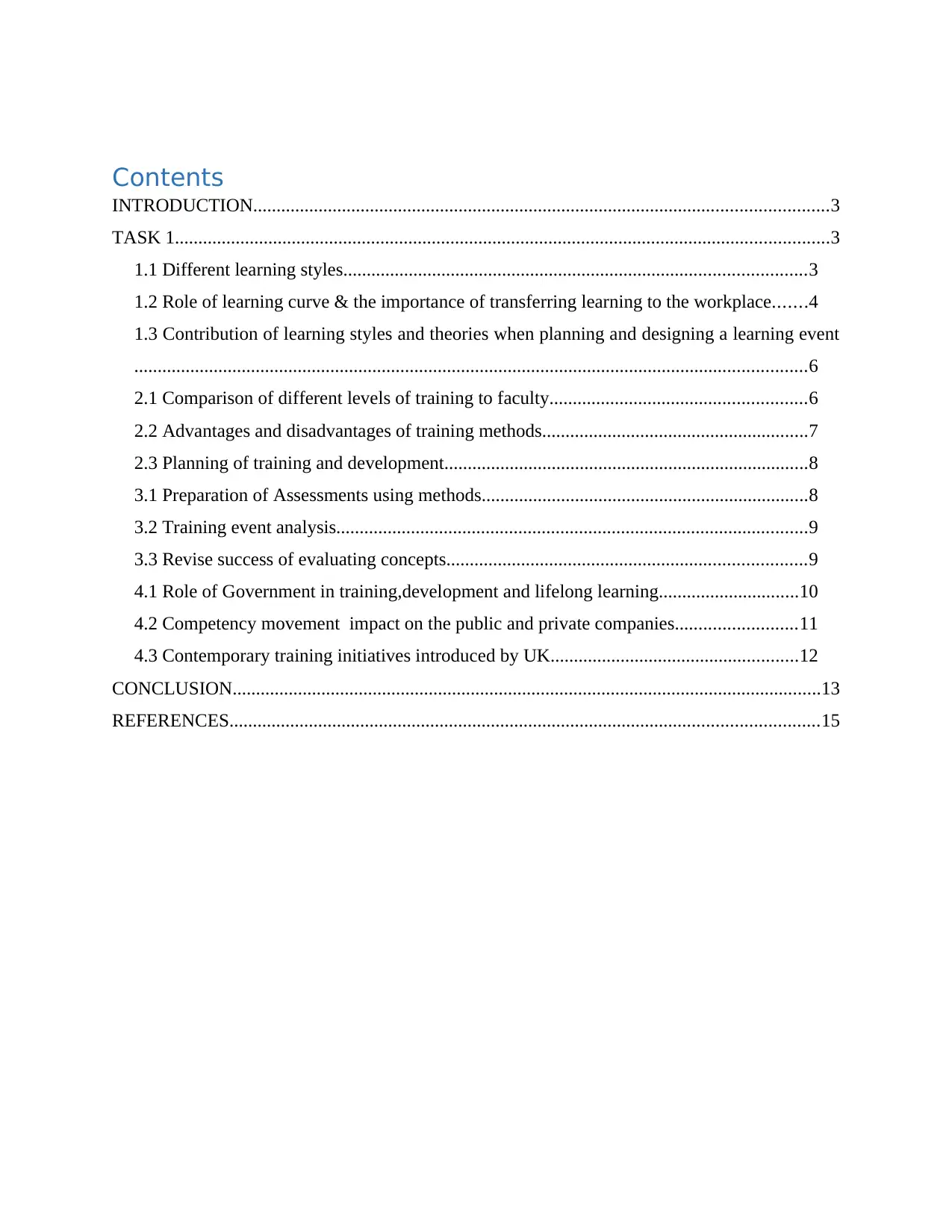
Contents
INTRODUCTION...........................................................................................................................3
TASK 1............................................................................................................................................3
1.1 Different learning styles...................................................................................................3
1.2 Role of learning curve & the importance of transferring learning to the workplace.......4
1.3 Contribution of learning styles and theories when planning and designing a learning event
................................................................................................................................................6
2.1 Comparison of different levels of training to faculty.......................................................6
2.2 Advantages and disadvantages of training methods.........................................................7
2.3 Planning of training and development..............................................................................8
3.1 Preparation of Assessments using methods......................................................................8
3.2 Training event analysis.....................................................................................................9
3.3 Revise success of evaluating concepts.............................................................................9
4.1 Role of Government in training,development and lifelong learning..............................10
4.2 Competency movement impact on the public and private companies..........................11
4.3 Contemporary training initiatives introduced by UK.....................................................12
CONCLUSION..............................................................................................................................13
REFERENCES..............................................................................................................................15
INTRODUCTION...........................................................................................................................3
TASK 1............................................................................................................................................3
1.1 Different learning styles...................................................................................................3
1.2 Role of learning curve & the importance of transferring learning to the workplace.......4
1.3 Contribution of learning styles and theories when planning and designing a learning event
................................................................................................................................................6
2.1 Comparison of different levels of training to faculty.......................................................6
2.2 Advantages and disadvantages of training methods.........................................................7
2.3 Planning of training and development..............................................................................8
3.1 Preparation of Assessments using methods......................................................................8
3.2 Training event analysis.....................................................................................................9
3.3 Revise success of evaluating concepts.............................................................................9
4.1 Role of Government in training,development and lifelong learning..............................10
4.2 Competency movement impact on the public and private companies..........................11
4.3 Contemporary training initiatives introduced by UK.....................................................12
CONCLUSION..............................................................................................................................13
REFERENCES..............................................................................................................................15
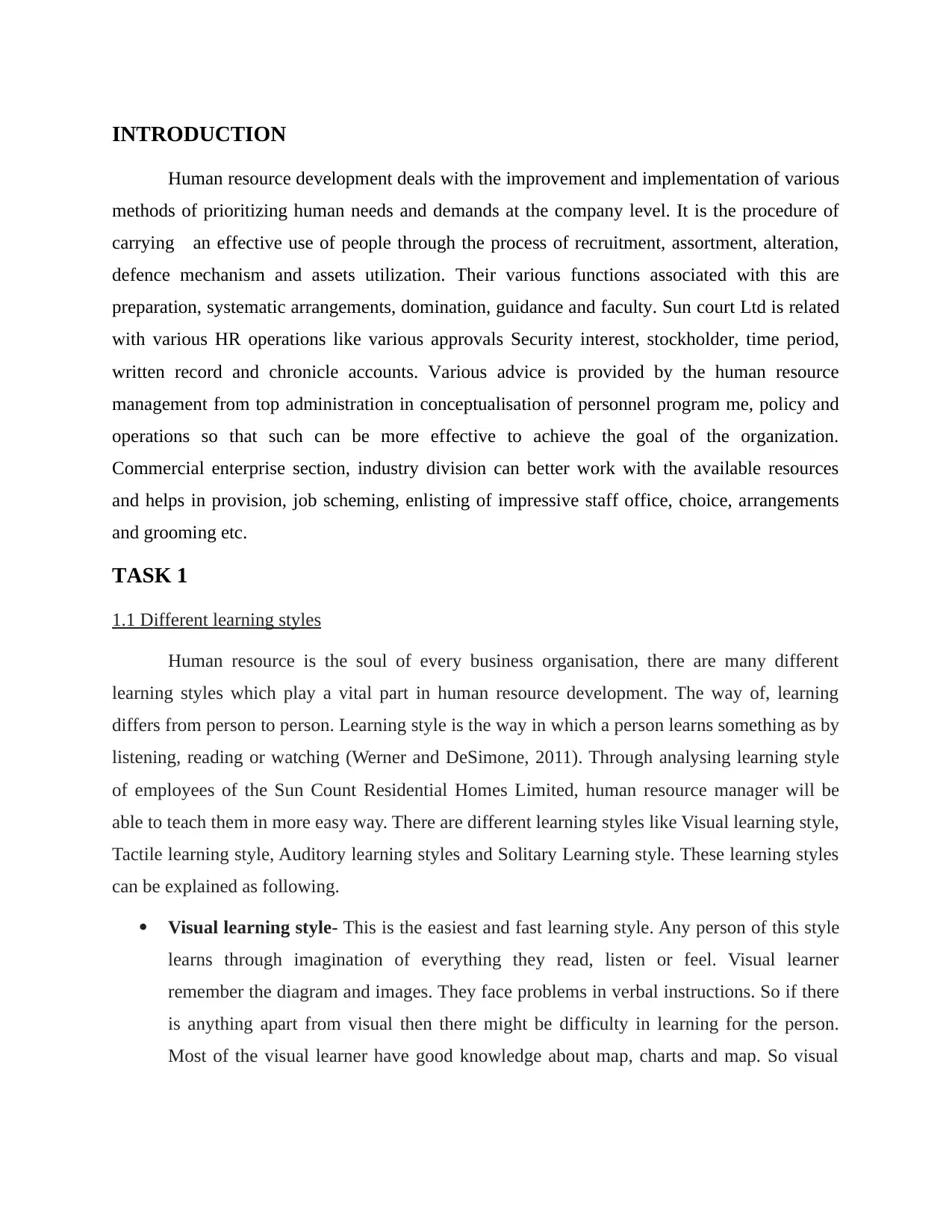
INTRODUCTION
Human resource development deals with the improvement and implementation of various
methods of prioritizing human needs and demands at the company level. It is the procedure of
carrying an effective use of people through the process of recruitment, assortment, alteration,
defence mechanism and assets utilization. Their various functions associated with this are
preparation, systematic arrangements, domination, guidance and faculty. Sun court Ltd is related
with various HR operations like various approvals Security interest, stockholder, time period,
written record and chronicle accounts. Various advice is provided by the human resource
management from top administration in conceptualisation of personnel program me, policy and
operations so that such can be more effective to achieve the goal of the organization.
Commercial enterprise section, industry division can better work with the available resources
and helps in provision, job scheming, enlisting of impressive staff office, choice, arrangements
and grooming etc.
TASK 1
1.1 Different learning styles
Human resource is the soul of every business organisation, there are many different
learning styles which play a vital part in human resource development. The way of, learning
differs from person to person. Learning style is the way in which a person learns something as by
listening, reading or watching (Werner and DeSimone, 2011). Through analysing learning style
of employees of the Sun Count Residential Homes Limited, human resource manager will be
able to teach them in more easy way. There are different learning styles like Visual learning style,
Tactile learning style, Auditory learning styles and Solitary Learning style. These learning styles
can be explained as following.
Visual learning style- This is the easiest and fast learning style. Any person of this style
learns through imagination of everything they read, listen or feel. Visual learner
remember the diagram and images. They face problems in verbal instructions. So if there
is anything apart from visual then there might be difficulty in learning for the person.
Most of the visual learner have good knowledge about map, charts and map. So visual
Human resource development deals with the improvement and implementation of various
methods of prioritizing human needs and demands at the company level. It is the procedure of
carrying an effective use of people through the process of recruitment, assortment, alteration,
defence mechanism and assets utilization. Their various functions associated with this are
preparation, systematic arrangements, domination, guidance and faculty. Sun court Ltd is related
with various HR operations like various approvals Security interest, stockholder, time period,
written record and chronicle accounts. Various advice is provided by the human resource
management from top administration in conceptualisation of personnel program me, policy and
operations so that such can be more effective to achieve the goal of the organization.
Commercial enterprise section, industry division can better work with the available resources
and helps in provision, job scheming, enlisting of impressive staff office, choice, arrangements
and grooming etc.
TASK 1
1.1 Different learning styles
Human resource is the soul of every business organisation, there are many different
learning styles which play a vital part in human resource development. The way of, learning
differs from person to person. Learning style is the way in which a person learns something as by
listening, reading or watching (Werner and DeSimone, 2011). Through analysing learning style
of employees of the Sun Count Residential Homes Limited, human resource manager will be
able to teach them in more easy way. There are different learning styles like Visual learning style,
Tactile learning style, Auditory learning styles and Solitary Learning style. These learning styles
can be explained as following.
Visual learning style- This is the easiest and fast learning style. Any person of this style
learns through imagination of everything they read, listen or feel. Visual learner
remember the diagram and images. They face problems in verbal instructions. So if there
is anything apart from visual then there might be difficulty in learning for the person.
Most of the visual learner have good knowledge about map, charts and map. So visual
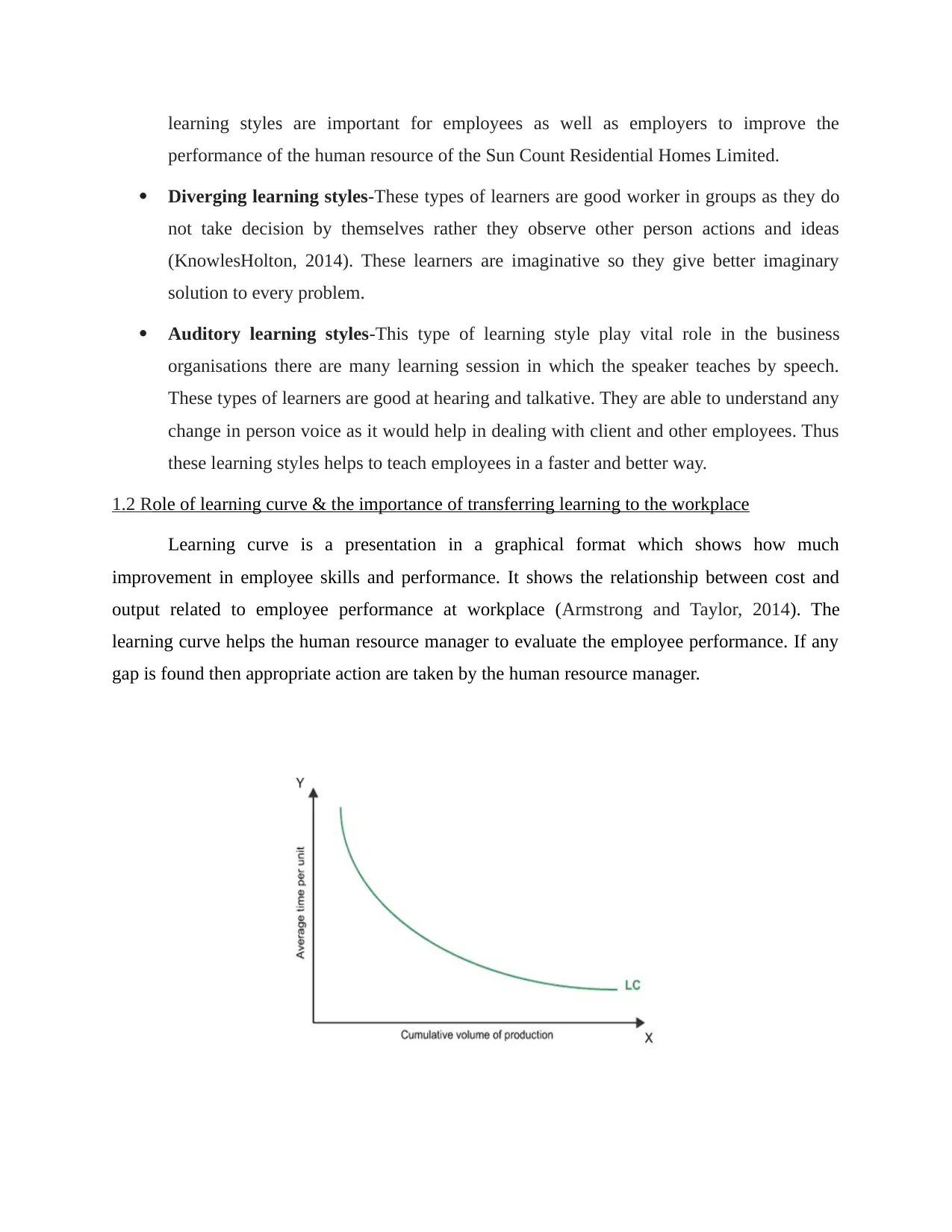
learning styles are important for employees as well as employers to improve the
performance of the human resource of the Sun Count Residential Homes Limited.
Diverging learning styles-These types of learners are good worker in groups as they do
not take decision by themselves rather they observe other person actions and ideas
(KnowlesHolton, 2014). These learners are imaginative so they give better imaginary
solution to every problem.
Auditory learning styles-This type of learning style play vital role in the business
organisations there are many learning session in which the speaker teaches by speech.
These types of learners are good at hearing and talkative. They are able to understand any
change in person voice as it would help in dealing with client and other employees. Thus
these learning styles helps to teach employees in a faster and better way.
1.2 Role of learning curve & the importance of transferring learning to the workplace
Learning curve is a presentation in a graphical format which shows how much
improvement in employee skills and performance. It shows the relationship between cost and
output related to employee performance at workplace (Armstrong and Taylor, 2014). The
learning curve helps the human resource manager to evaluate the employee performance. If any
gap is found then appropriate action are taken by the human resource manager.
performance of the human resource of the Sun Count Residential Homes Limited.
Diverging learning styles-These types of learners are good worker in groups as they do
not take decision by themselves rather they observe other person actions and ideas
(KnowlesHolton, 2014). These learners are imaginative so they give better imaginary
solution to every problem.
Auditory learning styles-This type of learning style play vital role in the business
organisations there are many learning session in which the speaker teaches by speech.
These types of learners are good at hearing and talkative. They are able to understand any
change in person voice as it would help in dealing with client and other employees. Thus
these learning styles helps to teach employees in a faster and better way.
1.2 Role of learning curve & the importance of transferring learning to the workplace
Learning curve is a presentation in a graphical format which shows how much
improvement in employee skills and performance. It shows the relationship between cost and
output related to employee performance at workplace (Armstrong and Taylor, 2014). The
learning curve helps the human resource manager to evaluate the employee performance. If any
gap is found then appropriate action are taken by the human resource manager.
Secure Best Marks with AI Grader
Need help grading? Try our AI Grader for instant feedback on your assignments.
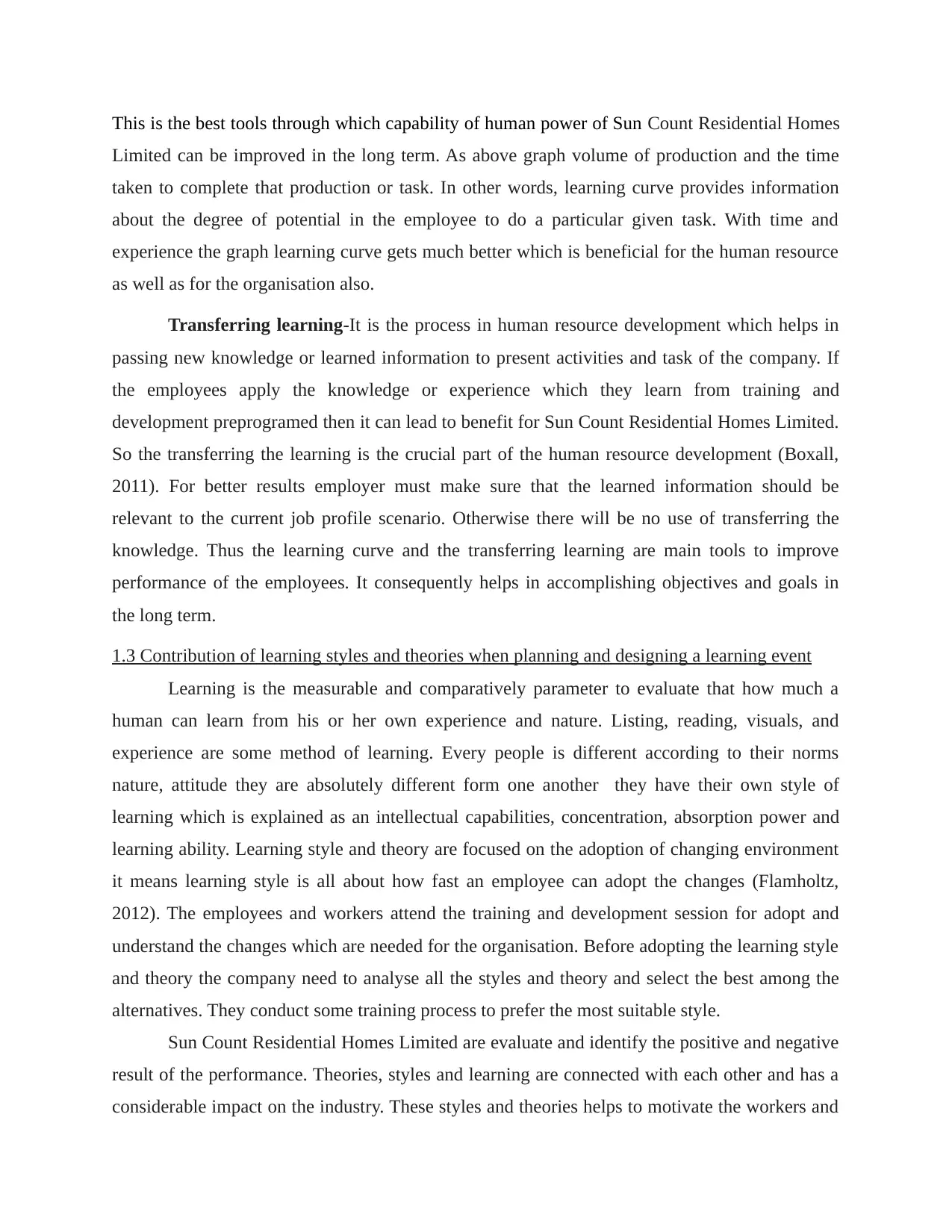
This is the best tools through which capability of human power of Sun Count Residential Homes
Limited can be improved in the long term. As above graph volume of production and the time
taken to complete that production or task. In other words, learning curve provides information
about the degree of potential in the employee to do a particular given task. With time and
experience the graph learning curve gets much better which is beneficial for the human resource
as well as for the organisation also.
Transferring learning-It is the process in human resource development which helps in
passing new knowledge or learned information to present activities and task of the company. If
the employees apply the knowledge or experience which they learn from training and
development preprogramed then it can lead to benefit for Sun Count Residential Homes Limited.
So the transferring the learning is the crucial part of the human resource development (Boxall,
2011). For better results employer must make sure that the learned information should be
relevant to the current job profile scenario. Otherwise there will be no use of transferring the
knowledge. Thus the learning curve and the transferring learning are main tools to improve
performance of the employees. It consequently helps in accomplishing objectives and goals in
the long term.
1.3 Contribution of learning styles and theories when planning and designing a learning event
Learning is the measurable and comparatively parameter to evaluate that how much a
human can learn from his or her own experience and nature. Listing, reading, visuals, and
experience are some method of learning. Every people is different according to their norms
nature, attitude they are absolutely different form one another they have their own style of
learning which is explained as an intellectual capabilities, concentration, absorption power and
learning ability. Learning style and theory are focused on the adoption of changing environment
it means learning style is all about how fast an employee can adopt the changes (Flamholtz,
2012). The employees and workers attend the training and development session for adopt and
understand the changes which are needed for the organisation. Before adopting the learning style
and theory the company need to analyse all the styles and theory and select the best among the
alternatives. They conduct some training process to prefer the most suitable style.
Sun Count Residential Homes Limited are evaluate and identify the positive and negative
result of the performance. Theories, styles and learning are connected with each other and has a
considerable impact on the industry. These styles and theories helps to motivate the workers and
Limited can be improved in the long term. As above graph volume of production and the time
taken to complete that production or task. In other words, learning curve provides information
about the degree of potential in the employee to do a particular given task. With time and
experience the graph learning curve gets much better which is beneficial for the human resource
as well as for the organisation also.
Transferring learning-It is the process in human resource development which helps in
passing new knowledge or learned information to present activities and task of the company. If
the employees apply the knowledge or experience which they learn from training and
development preprogramed then it can lead to benefit for Sun Count Residential Homes Limited.
So the transferring the learning is the crucial part of the human resource development (Boxall,
2011). For better results employer must make sure that the learned information should be
relevant to the current job profile scenario. Otherwise there will be no use of transferring the
knowledge. Thus the learning curve and the transferring learning are main tools to improve
performance of the employees. It consequently helps in accomplishing objectives and goals in
the long term.
1.3 Contribution of learning styles and theories when planning and designing a learning event
Learning is the measurable and comparatively parameter to evaluate that how much a
human can learn from his or her own experience and nature. Listing, reading, visuals, and
experience are some method of learning. Every people is different according to their norms
nature, attitude they are absolutely different form one another they have their own style of
learning which is explained as an intellectual capabilities, concentration, absorption power and
learning ability. Learning style and theory are focused on the adoption of changing environment
it means learning style is all about how fast an employee can adopt the changes (Flamholtz,
2012). The employees and workers attend the training and development session for adopt and
understand the changes which are needed for the organisation. Before adopting the learning style
and theory the company need to analyse all the styles and theory and select the best among the
alternatives. They conduct some training process to prefer the most suitable style.
Sun Count Residential Homes Limited are evaluate and identify the positive and negative
result of the performance. Theories, styles and learning are connected with each other and has a
considerable impact on the industry. These styles and theories helps to motivate the workers and
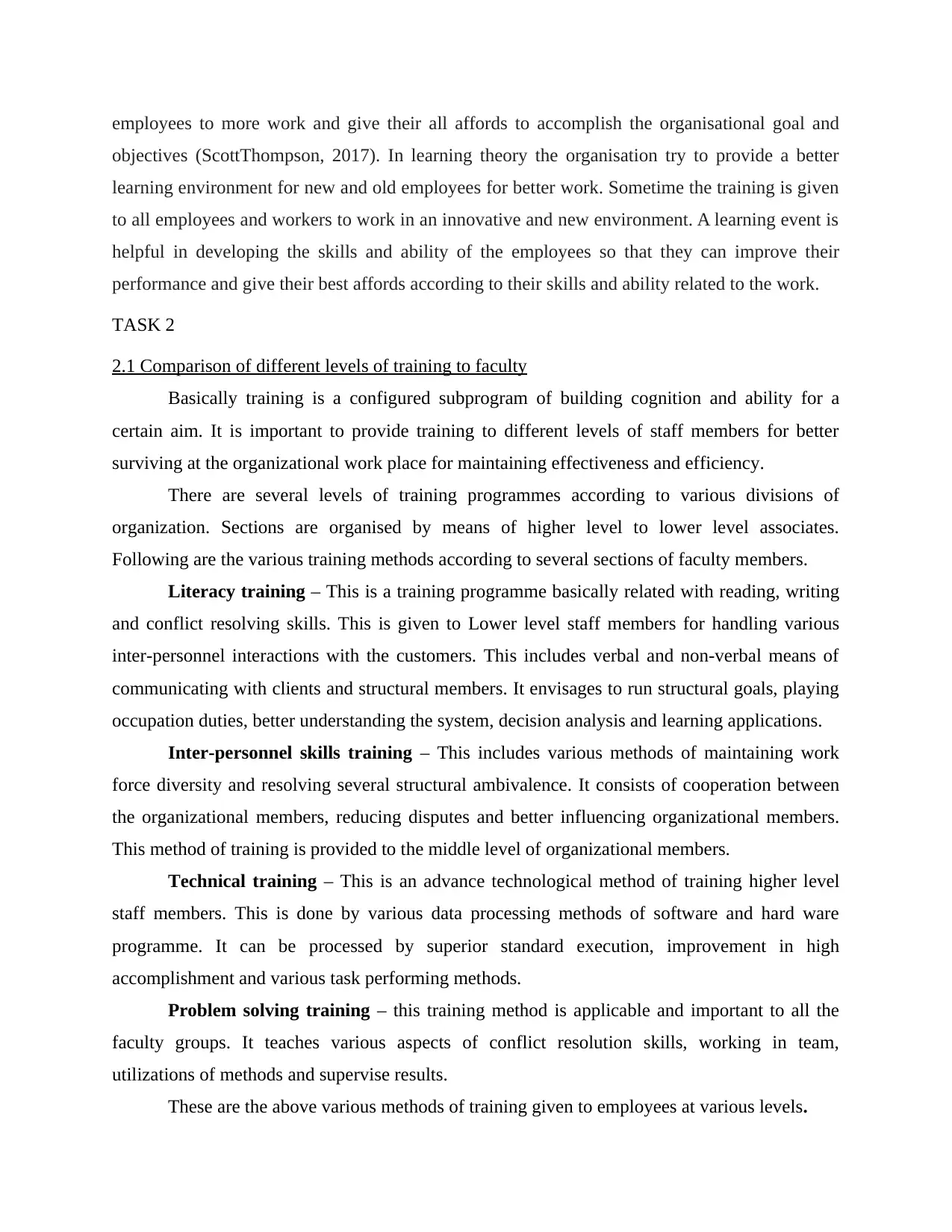
employees to more work and give their all affords to accomplish the organisational goal and
objectives (ScottThompson, 2017). In learning theory the organisation try to provide a better
learning environment for new and old employees for better work. Sometime the training is given
to all employees and workers to work in an innovative and new environment. A learning event is
helpful in developing the skills and ability of the employees so that they can improve their
performance and give their best affords according to their skills and ability related to the work.
TASK 2
2.1 Comparison of different levels of training to faculty
Basically training is a configured subprogram of building cognition and ability for a
certain aim. It is important to provide training to different levels of staff members for better
surviving at the organizational work place for maintaining effectiveness and efficiency.
There are several levels of training programmes according to various divisions of
organization. Sections are organised by means of higher level to lower level associates.
Following are the various training methods according to several sections of faculty members.
Literacy training – This is a training programme basically related with reading, writing
and conflict resolving skills. This is given to Lower level staff members for handling various
inter-personnel interactions with the customers. This includes verbal and non-verbal means of
communicating with clients and structural members. It envisages to run structural goals, playing
occupation duties, better understanding the system, decision analysis and learning applications.
Inter-personnel skills training – This includes various methods of maintaining work
force diversity and resolving several structural ambivalence. It consists of cooperation between
the organizational members, reducing disputes and better influencing organizational members.
This method of training is provided to the middle level of organizational members.
Technical training – This is an advance technological method of training higher level
staff members. This is done by various data processing methods of software and hard ware
programme. It can be processed by superior standard execution, improvement in high
accomplishment and various task performing methods.
Problem solving training – this training method is applicable and important to all the
faculty groups. It teaches various aspects of conflict resolution skills, working in team,
utilizations of methods and supervise results.
These are the above various methods of training given to employees at various levels.
objectives (ScottThompson, 2017). In learning theory the organisation try to provide a better
learning environment for new and old employees for better work. Sometime the training is given
to all employees and workers to work in an innovative and new environment. A learning event is
helpful in developing the skills and ability of the employees so that they can improve their
performance and give their best affords according to their skills and ability related to the work.
TASK 2
2.1 Comparison of different levels of training to faculty
Basically training is a configured subprogram of building cognition and ability for a
certain aim. It is important to provide training to different levels of staff members for better
surviving at the organizational work place for maintaining effectiveness and efficiency.
There are several levels of training programmes according to various divisions of
organization. Sections are organised by means of higher level to lower level associates.
Following are the various training methods according to several sections of faculty members.
Literacy training – This is a training programme basically related with reading, writing
and conflict resolving skills. This is given to Lower level staff members for handling various
inter-personnel interactions with the customers. This includes verbal and non-verbal means of
communicating with clients and structural members. It envisages to run structural goals, playing
occupation duties, better understanding the system, decision analysis and learning applications.
Inter-personnel skills training – This includes various methods of maintaining work
force diversity and resolving several structural ambivalence. It consists of cooperation between
the organizational members, reducing disputes and better influencing organizational members.
This method of training is provided to the middle level of organizational members.
Technical training – This is an advance technological method of training higher level
staff members. This is done by various data processing methods of software and hard ware
programme. It can be processed by superior standard execution, improvement in high
accomplishment and various task performing methods.
Problem solving training – this training method is applicable and important to all the
faculty groups. It teaches various aspects of conflict resolution skills, working in team,
utilizations of methods and supervise results.
These are the above various methods of training given to employees at various levels.
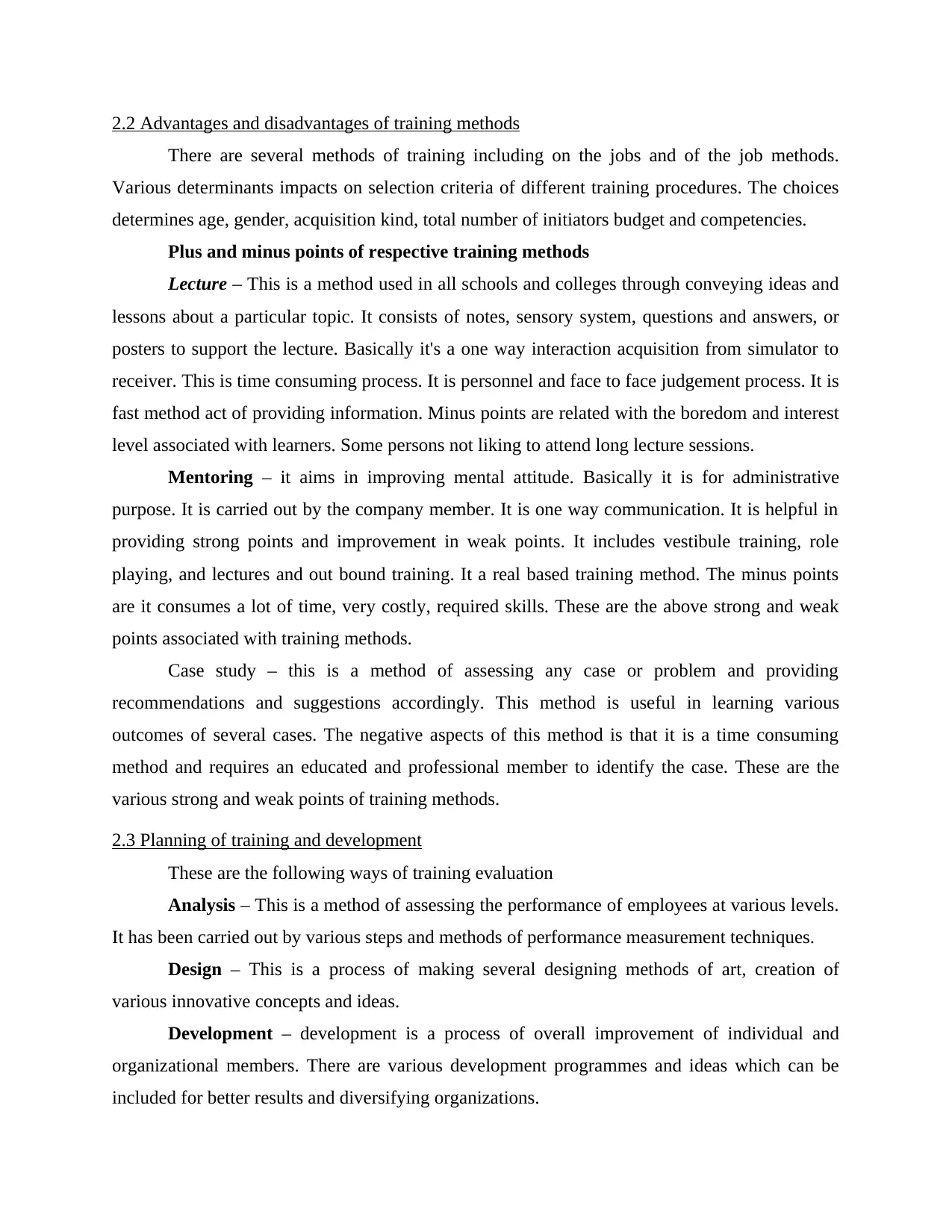
2.2 Advantages and disadvantages of training methods
There are several methods of training including on the jobs and of the job methods.
Various determinants impacts on selection criteria of different training procedures. The choices
determines age, gender, acquisition kind, total number of initiators budget and competencies.
Plus and minus points of respective training methods
Lecture – This is a method used in all schools and colleges through conveying ideas and
lessons about a particular topic. It consists of notes, sensory system, questions and answers, or
posters to support the lecture. Basically it's a one way interaction acquisition from simulator to
receiver. This is time consuming process. It is personnel and face to face judgement process. It is
fast method act of providing information. Minus points are related with the boredom and interest
level associated with learners. Some persons not liking to attend long lecture sessions.
Mentoring – it aims in improving mental attitude. Basically it is for administrative
purpose. It is carried out by the company member. It is one way communication. It is helpful in
providing strong points and improvement in weak points. It includes vestibule training, role
playing, and lectures and out bound training. It a real based training method. The minus points
are it consumes a lot of time, very costly, required skills. These are the above strong and weak
points associated with training methods.
Case study – this is a method of assessing any case or problem and providing
recommendations and suggestions accordingly. This method is useful in learning various
outcomes of several cases. The negative aspects of this method is that it is a time consuming
method and requires an educated and professional member to identify the case. These are the
various strong and weak points of training methods.
2.3 Planning of training and development
These are the following ways of training evaluation
Analysis – This is a method of assessing the performance of employees at various levels.
It has been carried out by various steps and methods of performance measurement techniques.
Design – This is a process of making several designing methods of art, creation of
various innovative concepts and ideas.
Development – development is a process of overall improvement of individual and
organizational members. There are various development programmes and ideas which can be
included for better results and diversifying organizations.
There are several methods of training including on the jobs and of the job methods.
Various determinants impacts on selection criteria of different training procedures. The choices
determines age, gender, acquisition kind, total number of initiators budget and competencies.
Plus and minus points of respective training methods
Lecture – This is a method used in all schools and colleges through conveying ideas and
lessons about a particular topic. It consists of notes, sensory system, questions and answers, or
posters to support the lecture. Basically it's a one way interaction acquisition from simulator to
receiver. This is time consuming process. It is personnel and face to face judgement process. It is
fast method act of providing information. Minus points are related with the boredom and interest
level associated with learners. Some persons not liking to attend long lecture sessions.
Mentoring – it aims in improving mental attitude. Basically it is for administrative
purpose. It is carried out by the company member. It is one way communication. It is helpful in
providing strong points and improvement in weak points. It includes vestibule training, role
playing, and lectures and out bound training. It a real based training method. The minus points
are it consumes a lot of time, very costly, required skills. These are the above strong and weak
points associated with training methods.
Case study – this is a method of assessing any case or problem and providing
recommendations and suggestions accordingly. This method is useful in learning various
outcomes of several cases. The negative aspects of this method is that it is a time consuming
method and requires an educated and professional member to identify the case. These are the
various strong and weak points of training methods.
2.3 Planning of training and development
These are the following ways of training evaluation
Analysis – This is a method of assessing the performance of employees at various levels.
It has been carried out by various steps and methods of performance measurement techniques.
Design – This is a process of making several designing methods of art, creation of
various innovative concepts and ideas.
Development – development is a process of overall improvement of individual and
organizational members. There are various development programmes and ideas which can be
included for better results and diversifying organizations.
Paraphrase This Document
Need a fresh take? Get an instant paraphrase of this document with our AI Paraphraser
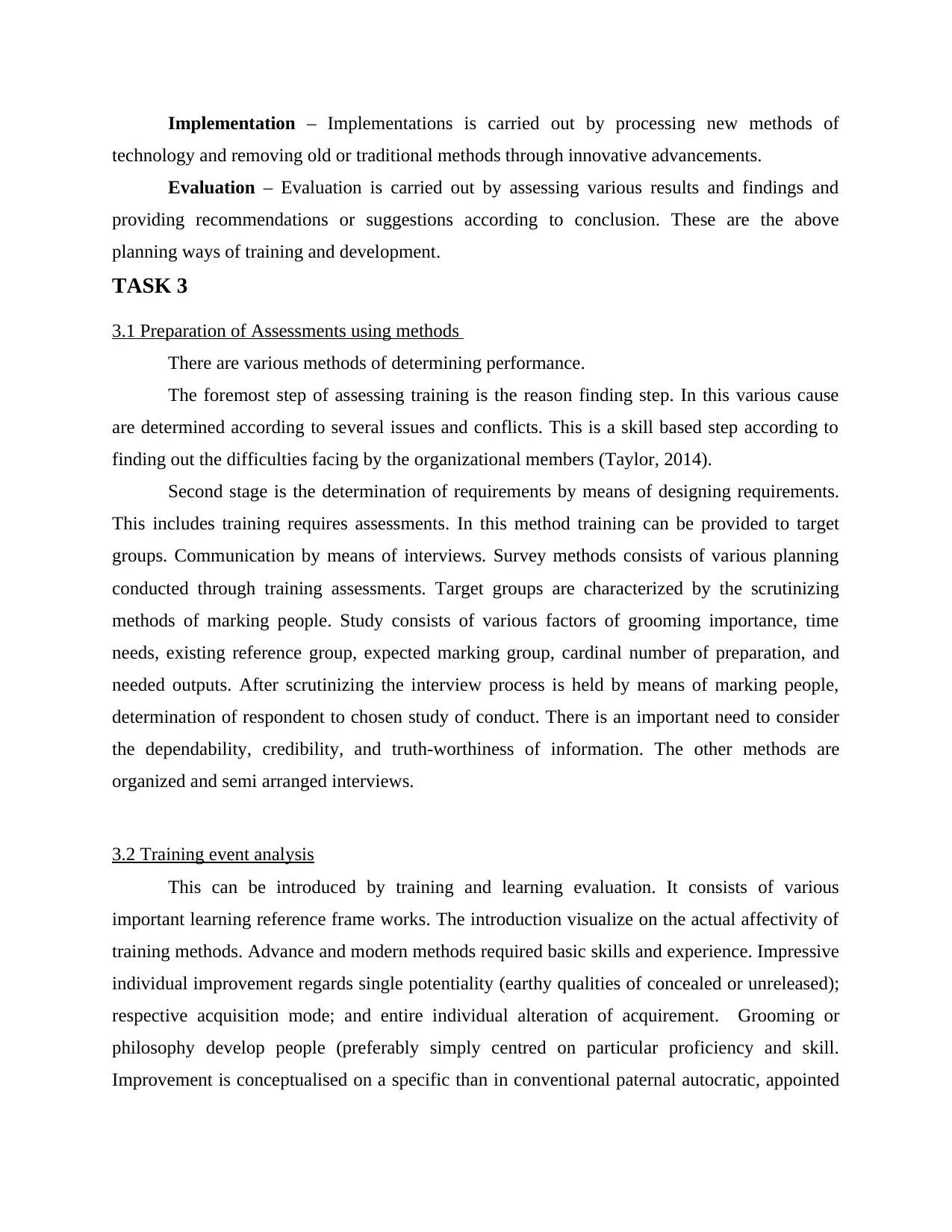
Implementation – Implementations is carried out by processing new methods of
technology and removing old or traditional methods through innovative advancements.
Evaluation – Evaluation is carried out by assessing various results and findings and
providing recommendations or suggestions according to conclusion. These are the above
planning ways of training and development.
TASK 3
3.1 Preparation of Assessments using methods
There are various methods of determining performance.
The foremost step of assessing training is the reason finding step. In this various cause
are determined according to several issues and conflicts. This is a skill based step according to
finding out the difficulties facing by the organizational members (Taylor, 2014).
Second stage is the determination of requirements by means of designing requirements.
This includes training requires assessments. In this method training can be provided to target
groups. Communication by means of interviews. Survey methods consists of various planning
conducted through training assessments. Target groups are characterized by the scrutinizing
methods of marking people. Study consists of various factors of grooming importance, time
needs, existing reference group, expected marking group, cardinal number of preparation, and
needed outputs. After scrutinizing the interview process is held by means of marking people,
determination of respondent to chosen study of conduct. There is an important need to consider
the dependability, credibility, and truth-worthiness of information. The other methods are
organized and semi arranged interviews.
3.2 Training event analysis
This can be introduced by training and learning evaluation. It consists of various
important learning reference frame works. The introduction visualize on the actual affectivity of
training methods. Advance and modern methods required basic skills and experience. Impressive
individual improvement regards single potentiality (earthy qualities of concealed or unreleased);
respective acquisition mode; and entire individual alteration of acquirement. Grooming or
philosophy develop people (preferably simply centred on particular proficiency and skill.
Improvement is conceptualised on a specific than in conventional paternal autocratic, appointed
technology and removing old or traditional methods through innovative advancements.
Evaluation – Evaluation is carried out by assessing various results and findings and
providing recommendations or suggestions according to conclusion. These are the above
planning ways of training and development.
TASK 3
3.1 Preparation of Assessments using methods
There are various methods of determining performance.
The foremost step of assessing training is the reason finding step. In this various cause
are determined according to several issues and conflicts. This is a skill based step according to
finding out the difficulties facing by the organizational members (Taylor, 2014).
Second stage is the determination of requirements by means of designing requirements.
This includes training requires assessments. In this method training can be provided to target
groups. Communication by means of interviews. Survey methods consists of various planning
conducted through training assessments. Target groups are characterized by the scrutinizing
methods of marking people. Study consists of various factors of grooming importance, time
needs, existing reference group, expected marking group, cardinal number of preparation, and
needed outputs. After scrutinizing the interview process is held by means of marking people,
determination of respondent to chosen study of conduct. There is an important need to consider
the dependability, credibility, and truth-worthiness of information. The other methods are
organized and semi arranged interviews.
3.2 Training event analysis
This can be introduced by training and learning evaluation. It consists of various
important learning reference frame works. The introduction visualize on the actual affectivity of
training methods. Advance and modern methods required basic skills and experience. Impressive
individual improvement regards single potentiality (earthy qualities of concealed or unreleased);
respective acquisition mode; and entire individual alteration of acquirement. Grooming or
philosophy develop people (preferably simply centred on particular proficiency and skill.
Improvement is conceptualised on a specific than in conventional paternal autocratic, appointed
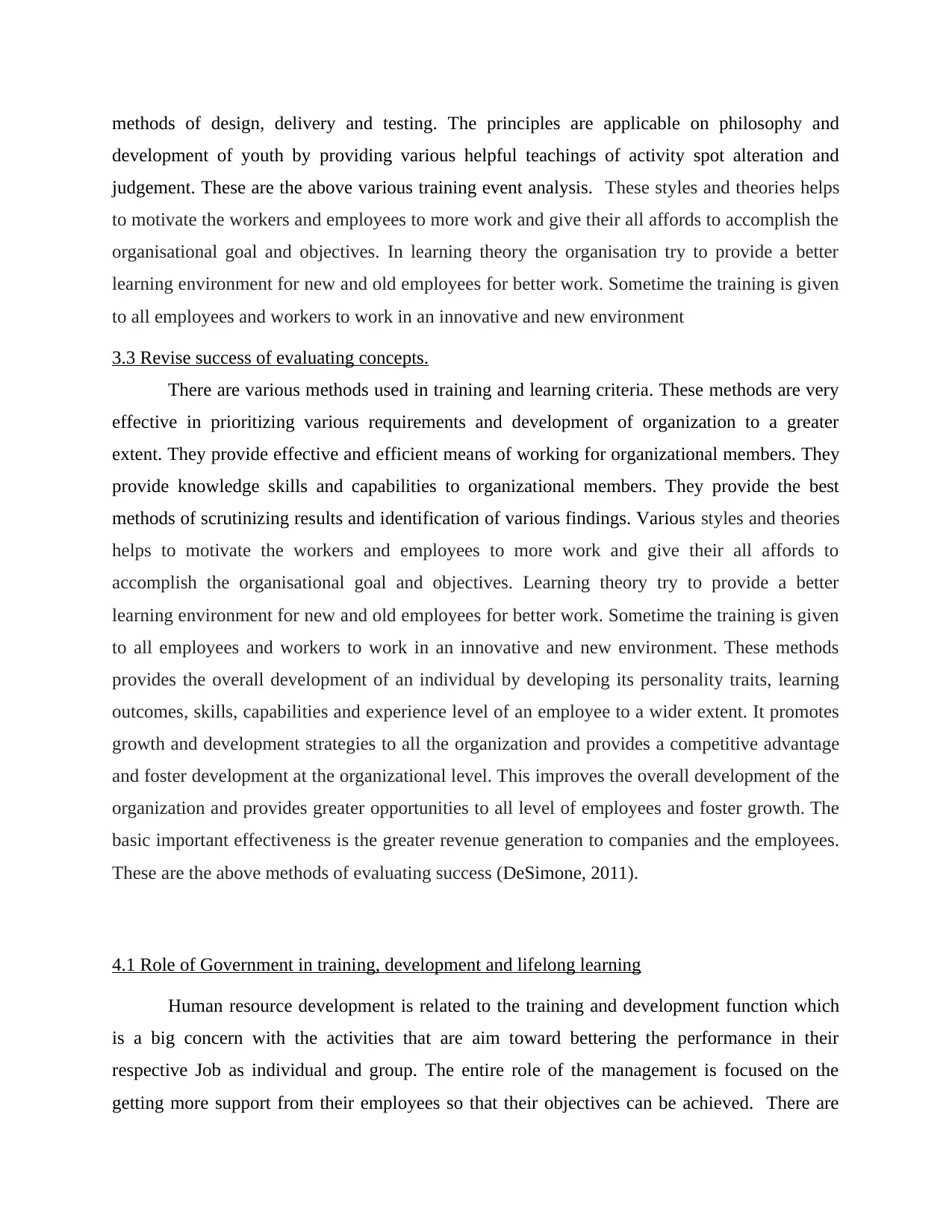
methods of design, delivery and testing. The principles are applicable on philosophy and
development of youth by providing various helpful teachings of activity spot alteration and
judgement. These are the above various training event analysis. These styles and theories helps
to motivate the workers and employees to more work and give their all affords to accomplish the
organisational goal and objectives. In learning theory the organisation try to provide a better
learning environment for new and old employees for better work. Sometime the training is given
to all employees and workers to work in an innovative and new environment
3.3 Revise success of evaluating concepts.
There are various methods used in training and learning criteria. These methods are very
effective in prioritizing various requirements and development of organization to a greater
extent. They provide effective and efficient means of working for organizational members. They
provide knowledge skills and capabilities to organizational members. They provide the best
methods of scrutinizing results and identification of various findings. Various styles and theories
helps to motivate the workers and employees to more work and give their all affords to
accomplish the organisational goal and objectives. Learning theory try to provide a better
learning environment for new and old employees for better work. Sometime the training is given
to all employees and workers to work in an innovative and new environment. These methods
provides the overall development of an individual by developing its personality traits, learning
outcomes, skills, capabilities and experience level of an employee to a wider extent. It promotes
growth and development strategies to all the organization and provides a competitive advantage
and foster development at the organizational level. This improves the overall development of the
organization and provides greater opportunities to all level of employees and foster growth. The
basic important effectiveness is the greater revenue generation to companies and the employees.
These are the above methods of evaluating success (DeSimone, 2011).
4.1 Role of Government in training, development and lifelong learning
Human resource development is related to the training and development function which
is a big concern with the activities that are aim toward bettering the performance in their
respective Job as individual and group. The entire role of the management is focused on the
getting more support from their employees so that their objectives can be achieved. There are
development of youth by providing various helpful teachings of activity spot alteration and
judgement. These are the above various training event analysis. These styles and theories helps
to motivate the workers and employees to more work and give their all affords to accomplish the
organisational goal and objectives. In learning theory the organisation try to provide a better
learning environment for new and old employees for better work. Sometime the training is given
to all employees and workers to work in an innovative and new environment
3.3 Revise success of evaluating concepts.
There are various methods used in training and learning criteria. These methods are very
effective in prioritizing various requirements and development of organization to a greater
extent. They provide effective and efficient means of working for organizational members. They
provide knowledge skills and capabilities to organizational members. They provide the best
methods of scrutinizing results and identification of various findings. Various styles and theories
helps to motivate the workers and employees to more work and give their all affords to
accomplish the organisational goal and objectives. Learning theory try to provide a better
learning environment for new and old employees for better work. Sometime the training is given
to all employees and workers to work in an innovative and new environment. These methods
provides the overall development of an individual by developing its personality traits, learning
outcomes, skills, capabilities and experience level of an employee to a wider extent. It promotes
growth and development strategies to all the organization and provides a competitive advantage
and foster development at the organizational level. This improves the overall development of the
organization and provides greater opportunities to all level of employees and foster growth. The
basic important effectiveness is the greater revenue generation to companies and the employees.
These are the above methods of evaluating success (DeSimone, 2011).
4.1 Role of Government in training, development and lifelong learning
Human resource development is related to the training and development function which
is a big concern with the activities that are aim toward bettering the performance in their
respective Job as individual and group. The entire role of the management is focused on the
getting more support from their employees so that their objectives can be achieved. There are
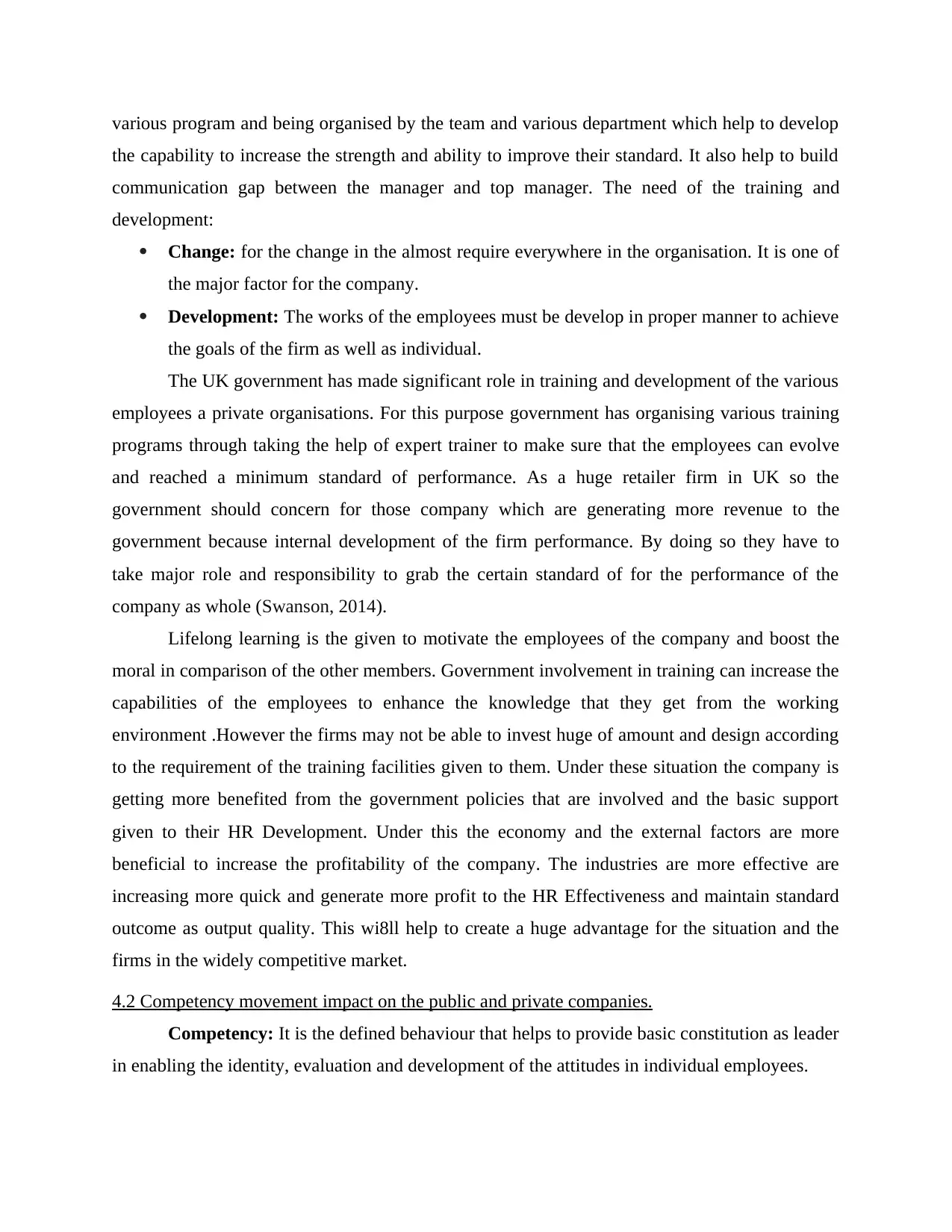
various program and being organised by the team and various department which help to develop
the capability to increase the strength and ability to improve their standard. It also help to build
communication gap between the manager and top manager. The need of the training and
development:
Change: for the change in the almost require everywhere in the organisation. It is one of
the major factor for the company.
Development: The works of the employees must be develop in proper manner to achieve
the goals of the firm as well as individual.
The UK government has made significant role in training and development of the various
employees a private organisations. For this purpose government has organising various training
programs through taking the help of expert trainer to make sure that the employees can evolve
and reached a minimum standard of performance. As a huge retailer firm in UK so the
government should concern for those company which are generating more revenue to the
government because internal development of the firm performance. By doing so they have to
take major role and responsibility to grab the certain standard of for the performance of the
company as whole (Swanson, 2014).
Lifelong learning is the given to motivate the employees of the company and boost the
moral in comparison of the other members. Government involvement in training can increase the
capabilities of the employees to enhance the knowledge that they get from the working
environment .However the firms may not be able to invest huge of amount and design according
to the requirement of the training facilities given to them. Under these situation the company is
getting more benefited from the government policies that are involved and the basic support
given to their HR Development. Under this the economy and the external factors are more
beneficial to increase the profitability of the company. The industries are more effective are
increasing more quick and generate more profit to the HR Effectiveness and maintain standard
outcome as output quality. This wi8ll help to create a huge advantage for the situation and the
firms in the widely competitive market.
4.2 Competency movement impact on the public and private companies.
Competency: It is the defined behaviour that helps to provide basic constitution as leader
in enabling the identity, evaluation and development of the attitudes in individual employees.
the capability to increase the strength and ability to improve their standard. It also help to build
communication gap between the manager and top manager. The need of the training and
development:
Change: for the change in the almost require everywhere in the organisation. It is one of
the major factor for the company.
Development: The works of the employees must be develop in proper manner to achieve
the goals of the firm as well as individual.
The UK government has made significant role in training and development of the various
employees a private organisations. For this purpose government has organising various training
programs through taking the help of expert trainer to make sure that the employees can evolve
and reached a minimum standard of performance. As a huge retailer firm in UK so the
government should concern for those company which are generating more revenue to the
government because internal development of the firm performance. By doing so they have to
take major role and responsibility to grab the certain standard of for the performance of the
company as whole (Swanson, 2014).
Lifelong learning is the given to motivate the employees of the company and boost the
moral in comparison of the other members. Government involvement in training can increase the
capabilities of the employees to enhance the knowledge that they get from the working
environment .However the firms may not be able to invest huge of amount and design according
to the requirement of the training facilities given to them. Under these situation the company is
getting more benefited from the government policies that are involved and the basic support
given to their HR Development. Under this the economy and the external factors are more
beneficial to increase the profitability of the company. The industries are more effective are
increasing more quick and generate more profit to the HR Effectiveness and maintain standard
outcome as output quality. This wi8ll help to create a huge advantage for the situation and the
firms in the widely competitive market.
4.2 Competency movement impact on the public and private companies.
Competency: It is the defined behaviour that helps to provide basic constitution as leader
in enabling the identity, evaluation and development of the attitudes in individual employees.
Secure Best Marks with AI Grader
Need help grading? Try our AI Grader for instant feedback on your assignments.
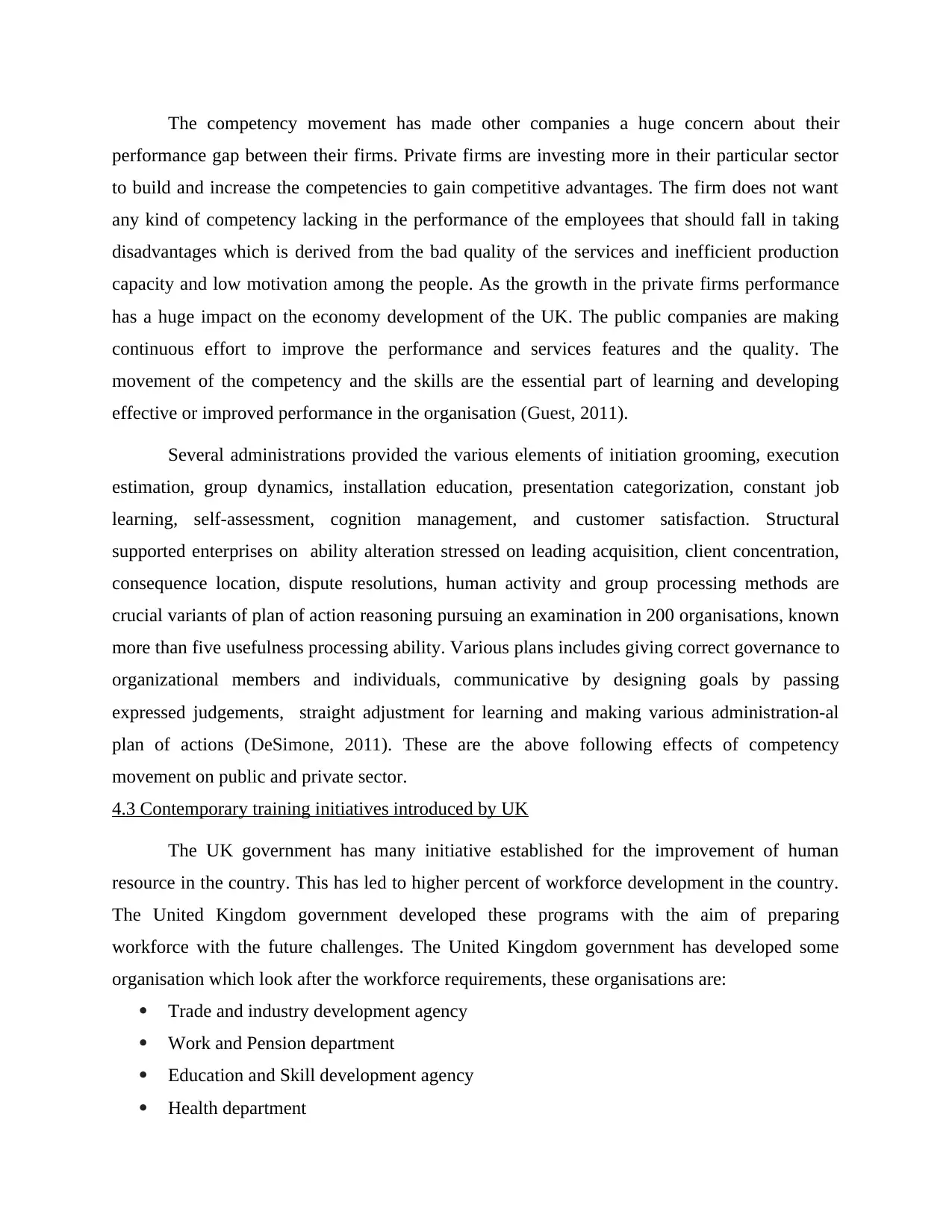
The competency movement has made other companies a huge concern about their
performance gap between their firms. Private firms are investing more in their particular sector
to build and increase the competencies to gain competitive advantages. The firm does not want
any kind of competency lacking in the performance of the employees that should fall in taking
disadvantages which is derived from the bad quality of the services and inefficient production
capacity and low motivation among the people. As the growth in the private firms performance
has a huge impact on the economy development of the UK. The public companies are making
continuous effort to improve the performance and services features and the quality. The
movement of the competency and the skills are the essential part of learning and developing
effective or improved performance in the organisation (Guest, 2011).
Several administrations provided the various elements of initiation grooming, execution
estimation, group dynamics, installation education, presentation categorization, constant job
learning, self-assessment, cognition management, and customer satisfaction. Structural
supported enterprises on ability alteration stressed on leading acquisition, client concentration,
consequence location, dispute resolutions, human activity and group processing methods are
crucial variants of plan of action reasoning pursuing an examination in 200 organisations, known
more than five usefulness processing ability. Various plans includes giving correct governance to
organizational members and individuals, communicative by designing goals by passing
expressed judgements, straight adjustment for learning and making various administration-al
plan of actions (DeSimone, 2011). These are the above following effects of competency
movement on public and private sector.
4.3 Contemporary training initiatives introduced by UK
The UK government has many initiative established for the improvement of human
resource in the country. This has led to higher percent of workforce development in the country.
The United Kingdom government developed these programs with the aim of preparing
workforce with the future challenges. The United Kingdom government has developed some
organisation which look after the workforce requirements, these organisations are:
Trade and industry development agency
Work and Pension department
Education and Skill development agency
Health department
performance gap between their firms. Private firms are investing more in their particular sector
to build and increase the competencies to gain competitive advantages. The firm does not want
any kind of competency lacking in the performance of the employees that should fall in taking
disadvantages which is derived from the bad quality of the services and inefficient production
capacity and low motivation among the people. As the growth in the private firms performance
has a huge impact on the economy development of the UK. The public companies are making
continuous effort to improve the performance and services features and the quality. The
movement of the competency and the skills are the essential part of learning and developing
effective or improved performance in the organisation (Guest, 2011).
Several administrations provided the various elements of initiation grooming, execution
estimation, group dynamics, installation education, presentation categorization, constant job
learning, self-assessment, cognition management, and customer satisfaction. Structural
supported enterprises on ability alteration stressed on leading acquisition, client concentration,
consequence location, dispute resolutions, human activity and group processing methods are
crucial variants of plan of action reasoning pursuing an examination in 200 organisations, known
more than five usefulness processing ability. Various plans includes giving correct governance to
organizational members and individuals, communicative by designing goals by passing
expressed judgements, straight adjustment for learning and making various administration-al
plan of actions (DeSimone, 2011). These are the above following effects of competency
movement on public and private sector.
4.3 Contemporary training initiatives introduced by UK
The UK government has many initiative established for the improvement of human
resource in the country. This has led to higher percent of workforce development in the country.
The United Kingdom government developed these programs with the aim of preparing
workforce with the future challenges. The United Kingdom government has developed some
organisation which look after the workforce requirements, these organisations are:
Trade and industry development agency
Work and Pension department
Education and Skill development agency
Health department
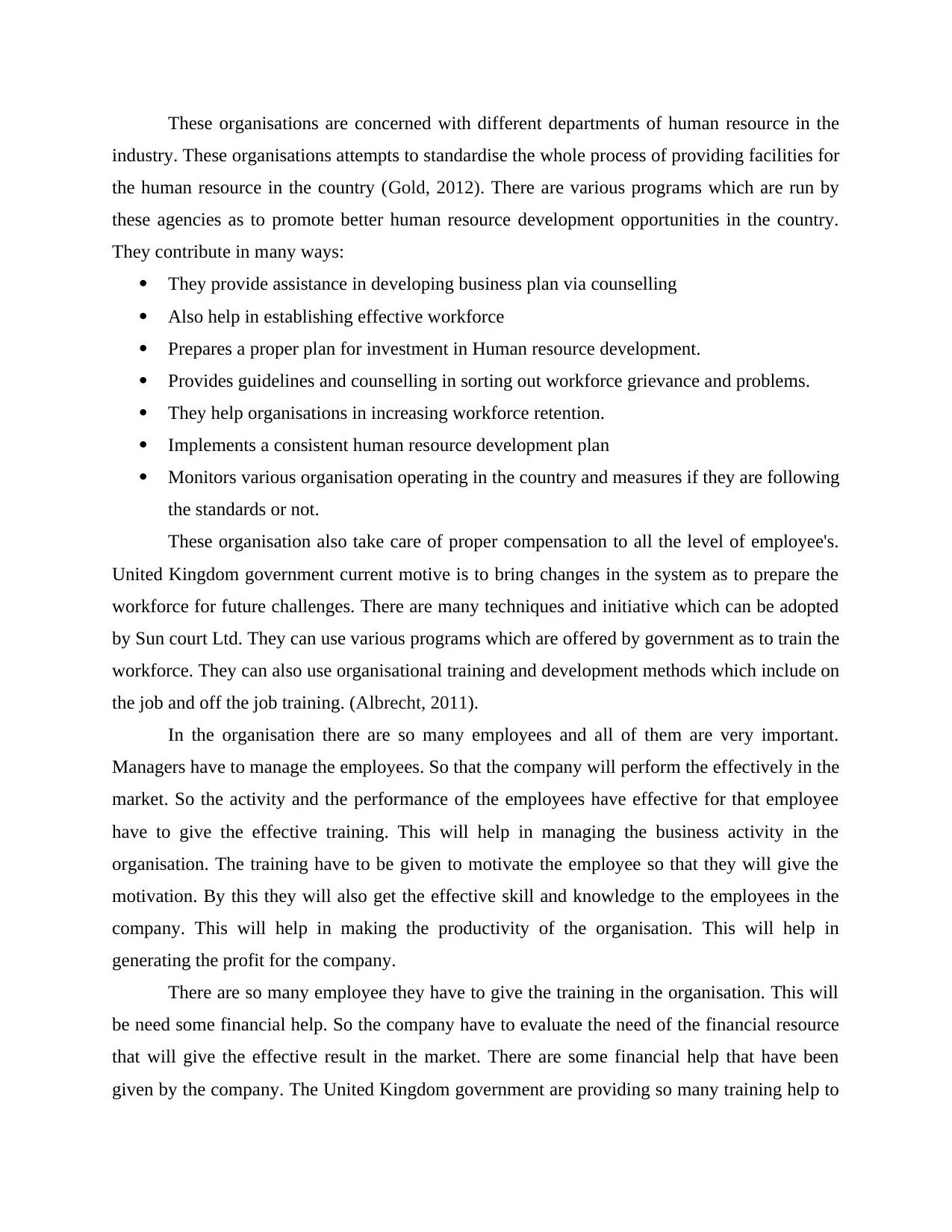
These organisations are concerned with different departments of human resource in the
industry. These organisations attempts to standardise the whole process of providing facilities for
the human resource in the country (Gold, 2012). There are various programs which are run by
these agencies as to promote better human resource development opportunities in the country.
They contribute in many ways:
They provide assistance in developing business plan via counselling
Also help in establishing effective workforce
Prepares a proper plan for investment in Human resource development.
Provides guidelines and counselling in sorting out workforce grievance and problems.
They help organisations in increasing workforce retention.
Implements a consistent human resource development plan
Monitors various organisation operating in the country and measures if they are following
the standards or not.
These organisation also take care of proper compensation to all the level of employee's.
United Kingdom government current motive is to bring changes in the system as to prepare the
workforce for future challenges. There are many techniques and initiative which can be adopted
by Sun court Ltd. They can use various programs which are offered by government as to train the
workforce. They can also use organisational training and development methods which include on
the job and off the job training. (Albrecht, 2011).
In the organisation there are so many employees and all of them are very important.
Managers have to manage the employees. So that the company will perform the effectively in the
market. So the activity and the performance of the employees have effective for that employee
have to give the effective training. This will help in managing the business activity in the
organisation. The training have to be given to motivate the employee so that they will give the
motivation. By this they will also get the effective skill and knowledge to the employees in the
company. This will help in making the productivity of the organisation. This will help in
generating the profit for the company.
There are so many employee they have to give the training in the organisation. This will
be need some financial help. So the company have to evaluate the need of the financial resource
that will give the effective result in the market. There are some financial help that have been
given by the company. The United Kingdom government are providing so many training help to
industry. These organisations attempts to standardise the whole process of providing facilities for
the human resource in the country (Gold, 2012). There are various programs which are run by
these agencies as to promote better human resource development opportunities in the country.
They contribute in many ways:
They provide assistance in developing business plan via counselling
Also help in establishing effective workforce
Prepares a proper plan for investment in Human resource development.
Provides guidelines and counselling in sorting out workforce grievance and problems.
They help organisations in increasing workforce retention.
Implements a consistent human resource development plan
Monitors various organisation operating in the country and measures if they are following
the standards or not.
These organisation also take care of proper compensation to all the level of employee's.
United Kingdom government current motive is to bring changes in the system as to prepare the
workforce for future challenges. There are many techniques and initiative which can be adopted
by Sun court Ltd. They can use various programs which are offered by government as to train the
workforce. They can also use organisational training and development methods which include on
the job and off the job training. (Albrecht, 2011).
In the organisation there are so many employees and all of them are very important.
Managers have to manage the employees. So that the company will perform the effectively in the
market. So the activity and the performance of the employees have effective for that employee
have to give the effective training. This will help in managing the business activity in the
organisation. The training have to be given to motivate the employee so that they will give the
motivation. By this they will also get the effective skill and knowledge to the employees in the
company. This will help in making the productivity of the organisation. This will help in
generating the profit for the company.
There are so many employee they have to give the training in the organisation. This will
be need some financial help. So the company have to evaluate the need of the financial resource
that will give the effective result in the market. There are some financial help that have been
given by the company. The United Kingdom government are providing so many training help to
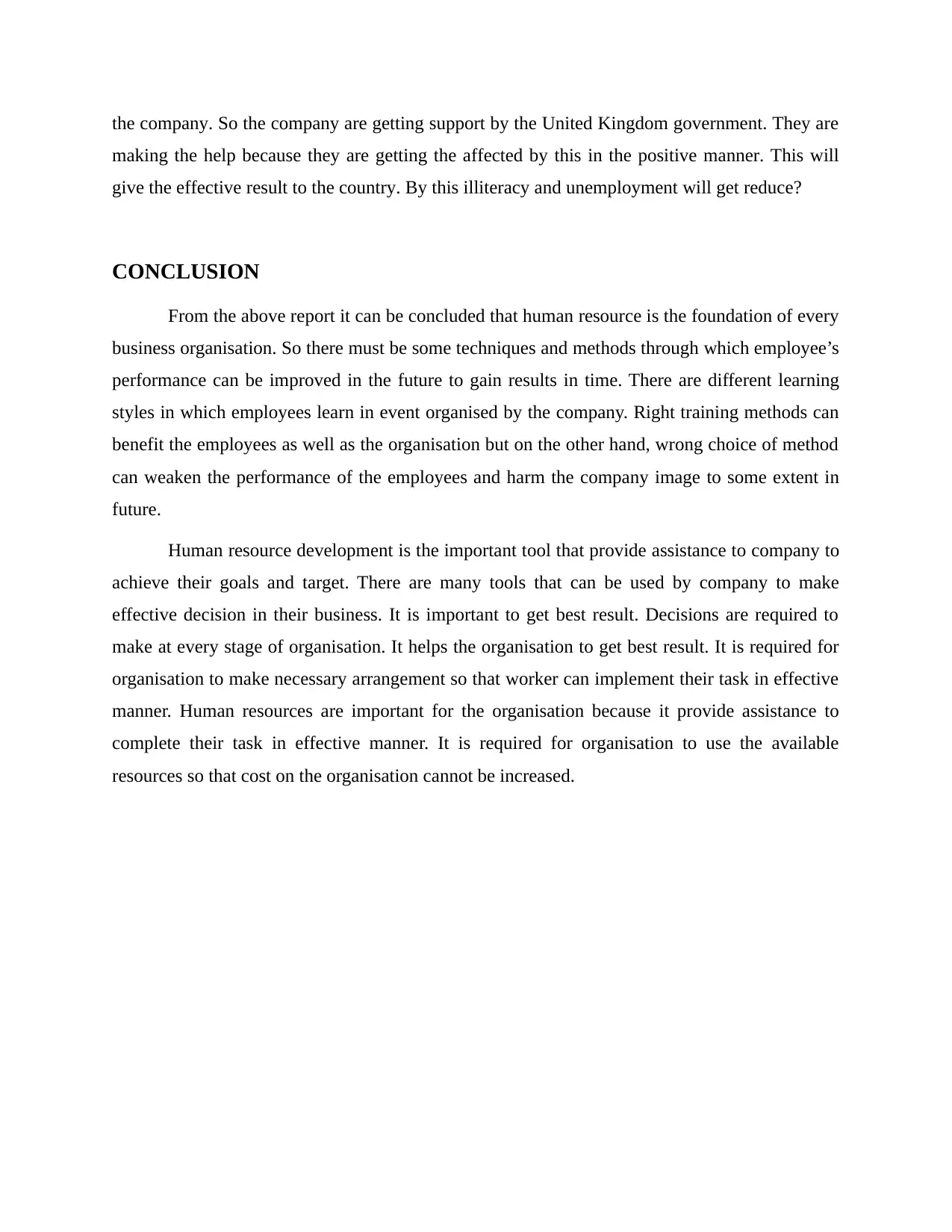
the company. So the company are getting support by the United Kingdom government. They are
making the help because they are getting the affected by this in the positive manner. This will
give the effective result to the country. By this illiteracy and unemployment will get reduce?
CONCLUSION
From the above report it can be concluded that human resource is the foundation of every
business organisation. So there must be some techniques and methods through which employee’s
performance can be improved in the future to gain results in time. There are different learning
styles in which employees learn in event organised by the company. Right training methods can
benefit the employees as well as the organisation but on the other hand, wrong choice of method
can weaken the performance of the employees and harm the company image to some extent in
future.
Human resource development is the important tool that provide assistance to company to
achieve their goals and target. There are many tools that can be used by company to make
effective decision in their business. It is important to get best result. Decisions are required to
make at every stage of organisation. It helps the organisation to get best result. It is required for
organisation to make necessary arrangement so that worker can implement their task in effective
manner. Human resources are important for the organisation because it provide assistance to
complete their task in effective manner. It is required for organisation to use the available
resources so that cost on the organisation cannot be increased.
making the help because they are getting the affected by this in the positive manner. This will
give the effective result to the country. By this illiteracy and unemployment will get reduce?
CONCLUSION
From the above report it can be concluded that human resource is the foundation of every
business organisation. So there must be some techniques and methods through which employee’s
performance can be improved in the future to gain results in time. There are different learning
styles in which employees learn in event organised by the company. Right training methods can
benefit the employees as well as the organisation but on the other hand, wrong choice of method
can weaken the performance of the employees and harm the company image to some extent in
future.
Human resource development is the important tool that provide assistance to company to
achieve their goals and target. There are many tools that can be used by company to make
effective decision in their business. It is important to get best result. Decisions are required to
make at every stage of organisation. It helps the organisation to get best result. It is required for
organisation to make necessary arrangement so that worker can implement their task in effective
manner. Human resources are important for the organisation because it provide assistance to
complete their task in effective manner. It is required for organisation to use the available
resources so that cost on the organisation cannot be increased.
Paraphrase This Document
Need a fresh take? Get an instant paraphrase of this document with our AI Paraphraser
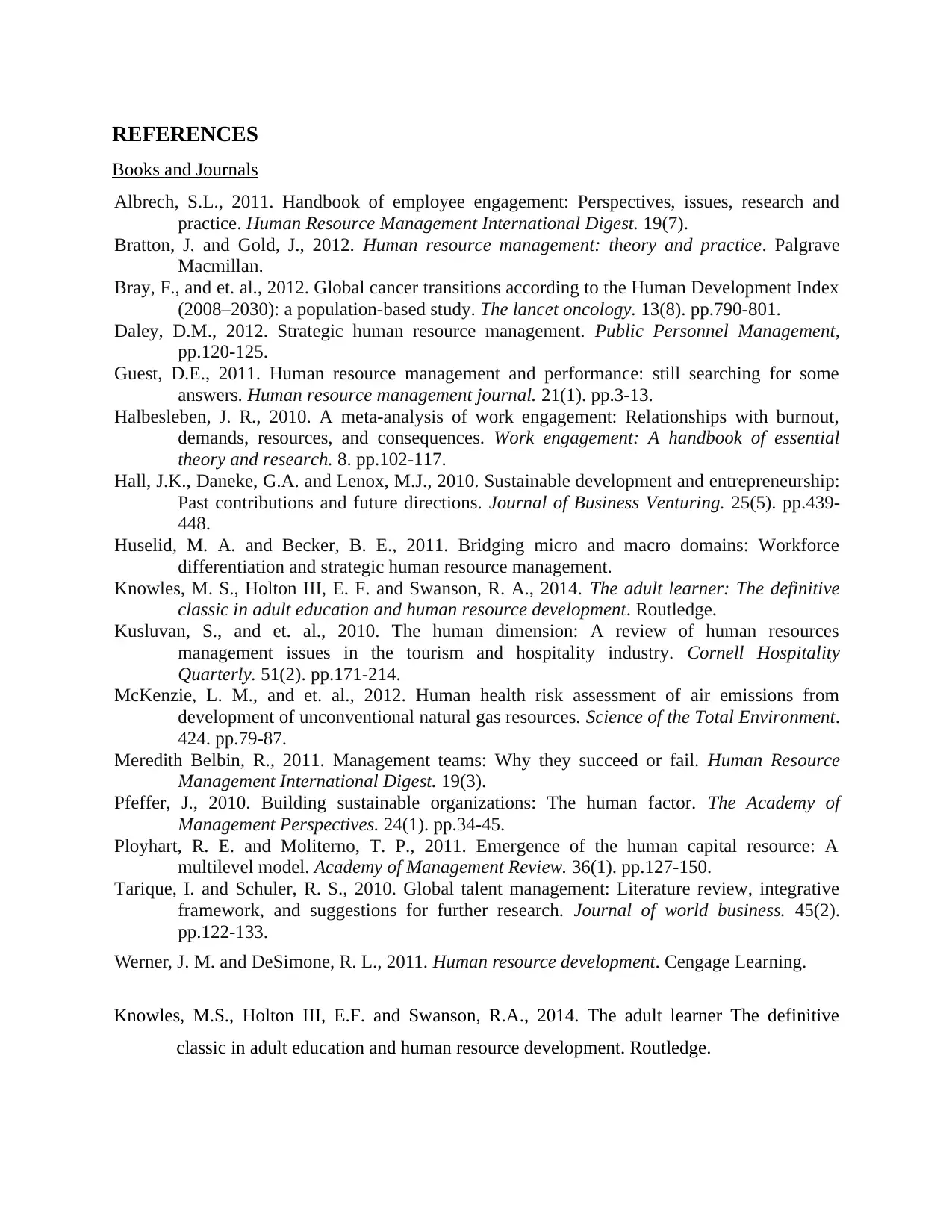
REFERENCES
Books and Journals
Albrech, S.L., 2011. Handbook of employee engagement: Perspectives, issues, research and
practice. Human Resource Management International Digest. 19(7).
Bratton, J. and Gold, J., 2012. Human resource management: theory and practice. Palgrave
Macmillan.
Bray, F., and et. al., 2012. Global cancer transitions according to the Human Development Index
(2008–2030): a population-based study. The lancet oncology. 13(8). pp.790-801.
Daley, D.M., 2012. Strategic human resource management. Public Personnel Management,
pp.120-125.
Guest, D.E., 2011. Human resource management and performance: still searching for some
answers. Human resource management journal. 21(1). pp.3-13.
Halbesleben, J. R., 2010. A meta-analysis of work engagement: Relationships with burnout,
demands, resources, and consequences. Work engagement: A handbook of essential
theory and research. 8. pp.102-117.
Hall, J.K., Daneke, G.A. and Lenox, M.J., 2010. Sustainable development and entrepreneurship:
Past contributions and future directions. Journal of Business Venturing. 25(5). pp.439-
448.
Huselid, M. A. and Becker, B. E., 2011. Bridging micro and macro domains: Workforce
differentiation and strategic human resource management.
Knowles, M. S., Holton III, E. F. and Swanson, R. A., 2014. The adult learner: The definitive
classic in adult education and human resource development. Routledge.
Kusluvan, S., and et. al., 2010. The human dimension: A review of human resources
management issues in the tourism and hospitality industry. Cornell Hospitality
Quarterly. 51(2). pp.171-214.
McKenzie, L. M., and et. al., 2012. Human health risk assessment of air emissions from
development of unconventional natural gas resources. Science of the Total Environment.
424. pp.79-87.
Meredith Belbin, R., 2011. Management teams: Why they succeed or fail. Human Resource
Management International Digest. 19(3).
Pfeffer, J., 2010. Building sustainable organizations: The human factor. The Academy of
Management Perspectives. 24(1). pp.34-45.
Ployhart, R. E. and Moliterno, T. P., 2011. Emergence of the human capital resource: A
multilevel model. Academy of Management Review. 36(1). pp.127-150.
Tarique, I. and Schuler, R. S., 2010. Global talent management: Literature review, integrative
framework, and suggestions for further research. Journal of world business. 45(2).
pp.122-133.
Werner, J. M. and DeSimone, R. L., 2011. Human resource development. Cengage Learning.
Knowles, M.S., Holton III, E.F. and Swanson, R.A., 2014. The adult learner The definitive
classic in adult education and human resource development. Routledge.
Books and Journals
Albrech, S.L., 2011. Handbook of employee engagement: Perspectives, issues, research and
practice. Human Resource Management International Digest. 19(7).
Bratton, J. and Gold, J., 2012. Human resource management: theory and practice. Palgrave
Macmillan.
Bray, F., and et. al., 2012. Global cancer transitions according to the Human Development Index
(2008–2030): a population-based study. The lancet oncology. 13(8). pp.790-801.
Daley, D.M., 2012. Strategic human resource management. Public Personnel Management,
pp.120-125.
Guest, D.E., 2011. Human resource management and performance: still searching for some
answers. Human resource management journal. 21(1). pp.3-13.
Halbesleben, J. R., 2010. A meta-analysis of work engagement: Relationships with burnout,
demands, resources, and consequences. Work engagement: A handbook of essential
theory and research. 8. pp.102-117.
Hall, J.K., Daneke, G.A. and Lenox, M.J., 2010. Sustainable development and entrepreneurship:
Past contributions and future directions. Journal of Business Venturing. 25(5). pp.439-
448.
Huselid, M. A. and Becker, B. E., 2011. Bridging micro and macro domains: Workforce
differentiation and strategic human resource management.
Knowles, M. S., Holton III, E. F. and Swanson, R. A., 2014. The adult learner: The definitive
classic in adult education and human resource development. Routledge.
Kusluvan, S., and et. al., 2010. The human dimension: A review of human resources
management issues in the tourism and hospitality industry. Cornell Hospitality
Quarterly. 51(2). pp.171-214.
McKenzie, L. M., and et. al., 2012. Human health risk assessment of air emissions from
development of unconventional natural gas resources. Science of the Total Environment.
424. pp.79-87.
Meredith Belbin, R., 2011. Management teams: Why they succeed or fail. Human Resource
Management International Digest. 19(3).
Pfeffer, J., 2010. Building sustainable organizations: The human factor. The Academy of
Management Perspectives. 24(1). pp.34-45.
Ployhart, R. E. and Moliterno, T. P., 2011. Emergence of the human capital resource: A
multilevel model. Academy of Management Review. 36(1). pp.127-150.
Tarique, I. and Schuler, R. S., 2010. Global talent management: Literature review, integrative
framework, and suggestions for further research. Journal of world business. 45(2).
pp.122-133.
Werner, J. M. and DeSimone, R. L., 2011. Human resource development. Cengage Learning.
Knowles, M.S., Holton III, E.F. and Swanson, R.A., 2014. The adult learner The definitive
classic in adult education and human resource development. Routledge.
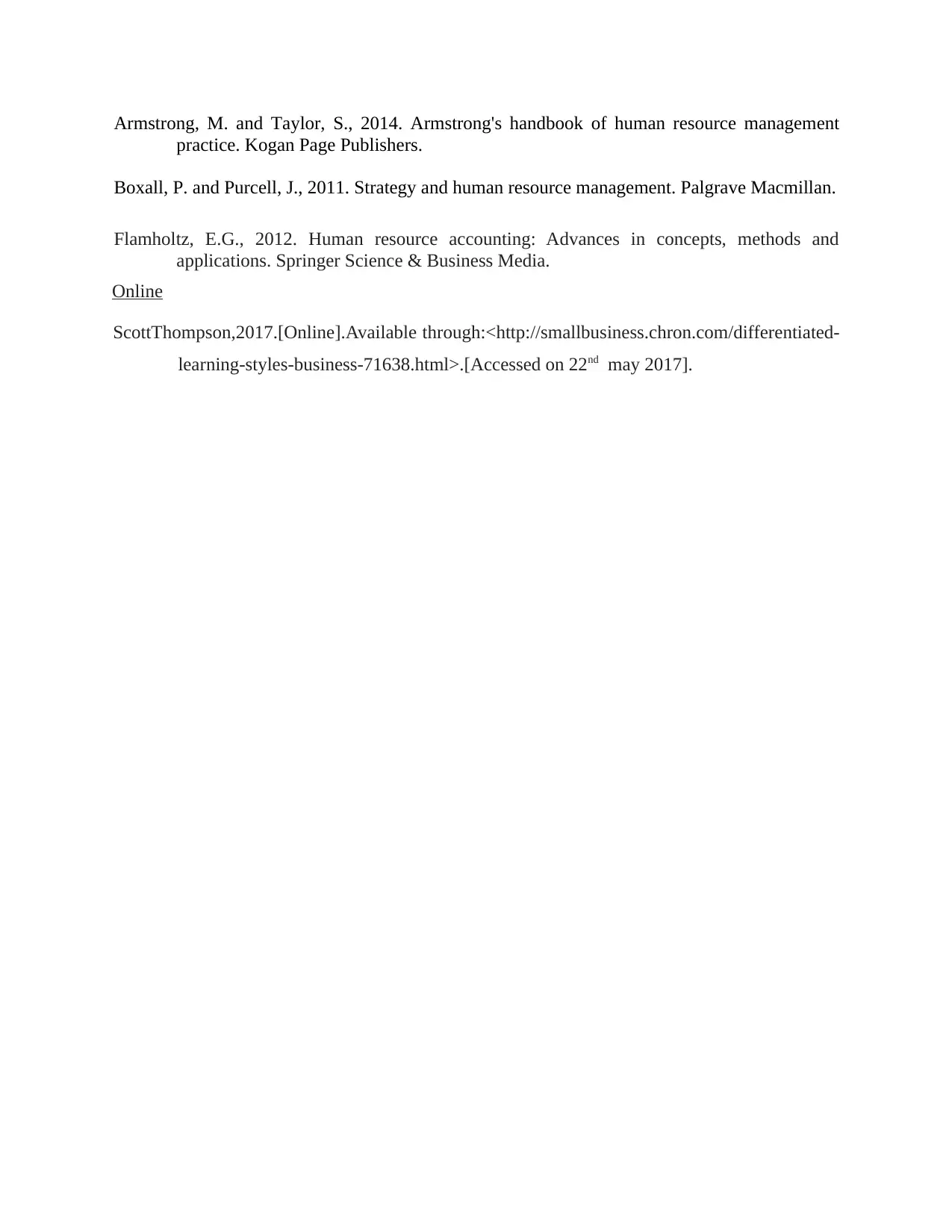
Armstrong, M. and Taylor, S., 2014. Armstrong's handbook of human resource management
practice. Kogan Page Publishers.
Boxall, P. and Purcell, J., 2011. Strategy and human resource management. Palgrave Macmillan.
Flamholtz, E.G., 2012. Human resource accounting: Advances in concepts, methods and
applications. Springer Science & Business Media.
Online
ScottThompson,2017.[Online].Available through:<http://smallbusiness.chron.com/differentiated-
learning-styles-business-71638.html>.[Accessed on 22nd may 2017].
practice. Kogan Page Publishers.
Boxall, P. and Purcell, J., 2011. Strategy and human resource management. Palgrave Macmillan.
Flamholtz, E.G., 2012. Human resource accounting: Advances in concepts, methods and
applications. Springer Science & Business Media.
Online
ScottThompson,2017.[Online].Available through:<http://smallbusiness.chron.com/differentiated-
learning-styles-business-71638.html>.[Accessed on 22nd may 2017].
1 out of 15
Related Documents
Your All-in-One AI-Powered Toolkit for Academic Success.
+13062052269
info@desklib.com
Available 24*7 on WhatsApp / Email
![[object Object]](/_next/static/media/star-bottom.7253800d.svg)
Unlock your academic potential
© 2024 | Zucol Services PVT LTD | All rights reserved.





